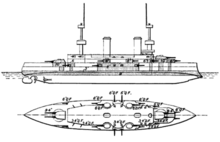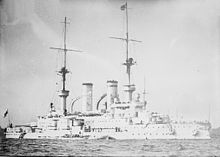SMS Wittelsbach
 SMS Wittelsbach
| |
| History | |
|---|---|
| Name | Wittelsbach |
| Namesake | House of Wittelsbach |
| Builder | Kaiserliche Werft Wilhelmshaven |
| Laid down | 30 September 1899 |
| Launched | 3 July 1900 |
| Commissioned | 15 October 1902 |
| Recommissioned | 1 June 1919 |
| Decommissioned | 24 August 1916 |
| Stricken | 8 March 1921 |
| Fate | Sold for scrap , 7 July 1921 |
| General characteristics | |
| Class and type | Wittelsbach-class pre-dreadnought battleship |
| Displacement |
|
| Length | 126.8 m (416 ft 0 in) (loa) |
| Beam | 22.8 m (74 ft 10 in) |
| Draft | 7.95 m (26 ft 1 in) |
| Installed power |
|
| Propulsion |
|
| Speed | 18 knots (33 km/h; 21 mph) |
| Range | 5,000 nautical miles (9,300 km; 5,800 mi); 10 knots (19 km/h; 12 mph) |
| Complement |
|
| Armament |
|
| Armor | |
SMS Wittelsbach
The ship served in I Squadron of the German fleet for the majority of her peacetime career, which spanned from 1902 to 1910. During this period, she was occupied with extensive annual training and making good-will visits to foreign countries. The training exercises during this period provided the framework for the
After the start of World War I in August 1914, Wittelsbach was brought back to active duty in IV Battle Squadron. The ship served in the
Description

After the German
Wittelsbach was 126.8 m (416 ft 0 in)
Wittelsbach's armament consisted of a
Service history
Construction to 1905
Wittelsbach's

On 1 March 1903, she became the
The fleet reassembled on 6 August and steamed back to Kiel, where it conducted a mock attack on the harbor on 12 August. During its cruise in the North Sea, the fleet experimented with
1905–1914
Wittelsbach took part in a pair of training cruises with I Squadron during 9–19 January and 27 February – 16 March 1905. Individual and squadron training followed, with an emphasis on gunnery drills. On 12 July, the fleet began a major training exercise in the North Sea. The fleet then cruised through the
In October, I Squadron went on a cruise in the Baltic. In early December, I and II Squadrons went on their regular winter cruise—this time to Danzig, where they arrived on 12 December. While on the return trip to Kiel, the fleet conducted tactical exercises. The fleet undertook a heavier training schedule in 1906 than in previous years. The ships were occupied with individual, division and squadron exercises throughout April. Starting on 13 May, major fleet exercises took place in the North Sea and lasted until 8 June with a cruise around the

The ship participated in the uneventful winter cruise into the Kattegat and Skagerrak from 8 to 16 December. The first quarter of 1907 followed the previous pattern and, on 16 February, the Active Battle Fleet was re-designated the
Wittelsbach was replaced as the deputy command flagship on 20 September 1910, again by Hannover, for decommissioning. Her crew was sent to man the newly commissioned
World War I

At the start of World War I, Wittelsbach was mobilized as part of IV Battle Squadron, under the command of VAdm
Two days later the ships were transferred to the North Sea, but stayed there only briefly, returning to the Baltic on 20 September. From 22 to 26 September, the squadron took part in a sweep into the eastern Baltic in an unsuccessful attempt to find and destroy Russian warships.[24] From 4 December 1914 to 2 April 1915, the ships of the IV Squadron were tasked with coastal defense duties along Germany's North Sea coast against incursions from the British Royal Navy. On 3 April, Wittelsbach went into drydock in Kiel for periodic maintenance, before conducting training exercises in the western Baltic with the other ships of VII Division of IV Squadron, which included Wettin, Schwaben, and Mecklenburg.[26]
The
From 27 May to 4 July, Wittelsbach was back in the North Sea, patrolling the mouths of the
Battle of the Gulf of Riga
The following month, the naval high command began an operation against the
During the action, the cruiser Thetis and the torpedo boat S144 were damaged by mines and the torpedo boats T52 and T58 were mined and sunk. Schmidt withdrew his ships to re-coal and Prince Heinrich debated making another attempt, as by that time it had become clear that the German Army's advance toward Riga had stalled. Prince Heinrich attempted to force the channel a second time using two dreadnought battleships from I Squadron to cover the minesweepers and leaving Wittelsbach behind in Libau. Following the unsuccessful second attempt, Schmidt became the I Squadron commander on 26 August, being replaced as the IV Squadron commander by VAdm Friedrich Schultz, who also made Wittelsbach his flagship.[28]
Subsequent activity

On 9 September, Wittelsbach and her four sisters sortied in an attempt to locate Russian warships off Gotland, but returned to port two days later without having engaged any opponents. On 7 and 8 October, she, Elsass, and four torpedo boats covered a minelaying operation. By this point in the war, the Navy was encountering difficulties in manning more important vessels.[28] The threat from submarines in the Baltic convinced the German navy to withdraw the elderly Wittelsbach-class ships from active service.[29] Wittelsbach and most of the other IV Squadron ships left Libau on 10 November, bound for Kiel; upon arrival the following day, they were designated the Reserve Division of the Baltic, commanded by Kommodore (Commodore) Walter Engelhardt. The ships were anchored in Schilksee in Kiel, with Wittelsbach as the divisional flagship. On 31 January 1916, the division was dissolved, and the ships were dispersed for subsidiary duties.[28]
Wittelsbach was decommissioned on 24 August, and was initially used as a
Notes
Footnotes
Citations
- ^ Sondhaus, pp. 180–189, 216–218, 221–225.
- ^ Herwig, p. 43.
- ^ Lyon, p. 248.
- ^ a b c d Gröner, p. 16.
- ^ a b c d Hildebrand, Röhr, & Steinmetz Vol. 8, p. 90.
- ^ Gröner, pp. 16–17.
- ^ Grießmer, p. 177.
- ^ Hildebrand, Röhr, & Steinmetz Vol. 5, pp. 48–51.
- ^ Hildebrand, Röhr, & Steinmetz Vol. 5, pp. 51–52.
- ^ Hildebrand, Röhr, & Steinmetz Vol. 5, p. 52.
- ^ Hildebrand, Röhr, & Steinmetz Vol. 5, p. 54.
- ^ Hildebrand, Röhr, & Steinmetz Vol. 5, pp. 54–55.
- ^ Campbell & Sieche, p. 134.
- ^ Hough, pp. 7–8.
- ^ Hildebrand, Röhr, & Steinmetz Vol. 8, p. 89.
- ^ Hildebrand, Röhr, & Steinmetz Vol. 5, p. 58.
- ^ Hildebrand, Röhr, & Steinmetz Vol. 5, p. 59.
- ^ Hildebrand, Röhr, & Steinmetz Vol. 5, p. 60.
- ^ Hildebrand, Röhr, & Steinmetz Vol. 5, pp. 60–62.
- ^ a b Hildebrand, Röhr, & Steinmetz Vol. 8, p. 91.
- ^ Staff, p. 32.
- ^ Hildebrand, Röhr, & Steinmetz Vol. 8, pp. 91–92.
- ^ Scheer, p. 15.
- ^ a b Hildebrand, Röhr, & Steinmetz Vol. 8, p. 92.
- ^ Halpern, p. 185.
- ^ a b c d e Hildebrand, Röhr, & Steinmetz Vol. 8, p. 93.
- ^ a b Halpern, p. 192.
- ^ a b c d e Hildebrand, Röhr, & Steinmetz Vol. 8, p. 94.
- ^ Herwig, p. 168.
- ^ a b Gröner, p. 17.
References
- Campbell, N. J. M. & Sieche, Erwin (1986). "Germany". In Gardiner, Robert & Gray, Randal (eds.). Conway's All the World's Fighting Ships 1906–1921. London: Conway Maritime Press. pp. 134–189. ISBN 978-0-85177-245-5.
- Grießmer, Axel (1999). Die Linienschiffe der Kaiserlichen Marine: 1906–1918; Konstruktionen zwischen Rüstungskonkurrenz und Flottengesetz [The Battleships of the Imperial Navy: 1906–1918; Constructions between Arms Competition and Fleet Laws] (in German). Bonn: Bernard & Graefe Verlag. ISBN 978-3-7637-5985-9.
- ISBN 978-0-87021-790-6.
- Halpern, Paul G. (1995). A Naval History of World War I. Annapolis: Naval Institute Press. ISBN 978-1-55750-352-7.
- Herwig, Holger (1998) [1980]. "Luxury" Fleet: The Imperial German Navy 1888–1918. Amherst: Humanity Books. ISBN 978-1-57392-286-9.
- Hildebrand, Hans H.; Röhr, Albert & Steinmetz, Hans-Otto (1993). Die Deutschen Kriegsschiffe: Biographien – ein Spiegel der Marinegeschichte von 1815 bis zur Gegenwart [The German Warships: Biographies − A Reflection of Naval History from 1815 to the Present] (in German). Vol. 5. Ratingen: Mundus Verlag. ISBN 978-3-7822-0456-9.
- Hildebrand, Hans H.; Röhr, Albert & Steinmetz, Hans-Otto (1993). Die Deutschen Kriegsschiffe: Biographien – ein Spiegel der Marinegeschichte von 1815 bis zur Gegenwart [The German Warships: Biographies − A Reflection of Naval History from 1815 to the Present] (in German). Vol. 8. Ratingen: Mundus Verlag.
- Hough, Richard (1980). Falklands 1914: The Pursuit of Admiral Von Spee. Penzance: Periscope Publishing. ISBN 978-1-904381-12-9.
- Lyon, Hugh (1979). "Germany". In Gardiner, Robert; Chesneau, Roger; Kolesnik, Eugene M. (eds.). Conway's All the World's Fighting Ships 1860–1905. Greenwich: Conway Maritime Press. ISBN 978-0-85177-133-5.
- Scheer, Reinhard (1920). Germany's High Seas Fleet in the World War. London: Cassell and Company. OCLC 2765294.
- Sondhaus, Lawrence (1997). Preparing for Weltpolitik: German Sea Power Before the Tirpitz Era. Annapolis: Naval Institute Press. ISBN 978-1-55750-745-7.
- Staff, Gary (2010). German Battleships: 1914–1918. Vol. 1. Oxford: Osprey Books. ISBN 978-1-84603-467-1.
Further reading
- Koop, Gerhard & Schmolke, Klaus-Peter (2001). Die Panzer- und Linienschiffe der Brandenburg-, Kaiser Friedrich III-, Wittlesbach-, Braunschweig- und Deutschland-Klasse [The Armored and Battleships of the Brandenburg, Kaiser Friedrich III, Wittelsbach, Braunschweig, and Deutschland Classes] (in German). Bonn: Bernard & Graefe Verlag. ISBN 978-3-7637-6211-8.
